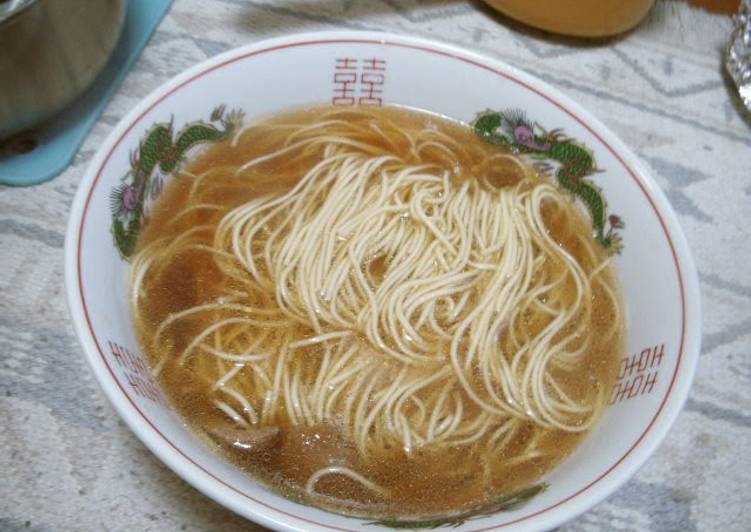Soy Sauce Ramen By A Ramen Master. On this episode of At Home Cooking, we break down one of the most essential elements of a Ramen bowl: TARE SAUCE! Ramen Egg (Ajitsuke Tamago) - eggs marinated in soy sauce base sauce. Important: Prepare ramen toppings ahead of time so you can serve ramen hot immediately.
 Kikkoman brand soy sauce is often found in most restaurants across the United States and Shoyu Tare is the soy sauce seasoning and concentrated flavor base used in Japanese Shoyu Ramen; one of the most important. Shoyu: Japanese soy sauce is a popular ramen seasoning in the Kanto region of central Japan, originally emanating from Yokohama. Traditionally it's paired with clear to brown chicken, seafood, and occasionally pork or beef-based broths, though these days shoyu is used willy-nilly by ramen chefs. You can cook Soy Sauce Ramen By A Ramen Master using 10 ingredients and 12 steps. Here is how you achieve it.
Kikkoman brand soy sauce is often found in most restaurants across the United States and Shoyu Tare is the soy sauce seasoning and concentrated flavor base used in Japanese Shoyu Ramen; one of the most important. Shoyu: Japanese soy sauce is a popular ramen seasoning in the Kanto region of central Japan, originally emanating from Yokohama. Traditionally it's paired with clear to brown chicken, seafood, and occasionally pork or beef-based broths, though these days shoyu is used willy-nilly by ramen chefs. You can cook Soy Sauce Ramen By A Ramen Master using 10 ingredients and 12 steps. Here is how you achieve it.
Ingredients of Soy Sauce Ramen By A Ramen Master
- You need 1 of Chicken carcass (for the soup).
- You need 1 of Leeks (for the soup).
- You need 1 of knob Ginger (for the soup).
- Prepare 3 clove of Garlic (for the soup).
- Prepare 1 of handful Dried infant sardines (for the soup).
- You need 1400 ml of Water (for the soup).
- It's 100 grams of Chicken skin (for the sauce).
- Prepare 1 of ladleful Soy sauce (for the sauce).
- You need 1 tbsp of Sake (for the sauce).
- You need 1 of whatever you prefer Noodles.
Kogashi - or charred - ramen has arrived in Australia with the Sydney opening of Gogyo, a Japanese The charred soup is made from a chicken stock base and seasoned with either shoyu soy sauce or The ramen master knows what's best. Many hours of testing and research have gone into finding the. This shoyu (soy sauce) ramen recipe is quick and easy. It uses chicken stock and chukamen noodles for a relatively light soup that is salty and tangy.
Soy Sauce Ramen By A Ramen Master instructions
- Make the soup: Soak a handful of dried infant sardines in 1 cup of hot water. I pack the dried sardines into a clean tea bag for easy clean up..
- If you bring the fish broth to a boil, the flavor will become concentrated, but if you prefer a lighter aromatic flavor, turn off the heat once the pot comes to a boil and cover with a lid..
- The main feature of the stock is the chicken. Bring 6 cups of water, the chicken, leek, ginger, and garlic to a boil and skim off the scum..
- After 30 minutes, you'll have a clear chicken soup stock, but if you prefer a more concentrated flavor, boil it for longer. I boiled mine for an hour..
- This is the resultant soup. If you skim the scum and fat off the top, you'll have a clear soup..
- Once the soup is done, make the sauce. The sauce is based off the umami from the chicken skin. In a cold saucepan, lay the skins on the bottom and sauté over low heat..
- Once the skins have crisped from their own oils, add sake to remove any unwanted odors, and add a ladleful each of the chicken soup stock and soy sauce..
- Once the pot comes to a boil, turn off the heat, cover with a lid, and wait until it cools. The flavors will meld once it has sufficiently cooled. The soy sauce flavor is pretty harsh if you taste it immediately after simmering..
- I'm not that adventurous with the prep work, so I just combine the chicken soup stock and niboshi dashi stock together. Once they're mixed together, turn up the heat..
- Pour the sauce to the ramen bowl. Add about 50 g of chicken skin and 1-2 Chinese spoons full the sauce. When you add the ramen broth, taste and adjust to your preference..
- The combined ramen broth looks like this..
- Add your favorite ramen noodles, garnish and it's done!!.
Ramen is a Japanese noodle dish with as many variations on it as there are regions in Japan. It's basically a noodle soup, most often made with a. Shoyu, or soy sauce, is the oldest style of tare. Ramen doesn't exist without this one, because the origins of ramen lie in Japanese cooks Instead of just having a soy ramen, a restaurant can make multiple tares and have several different options, all while having to make only one master broth. Top ramen soy sauce is vegetarian!
0 Komentar